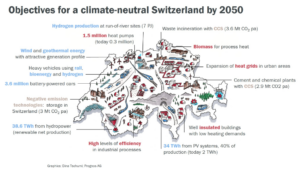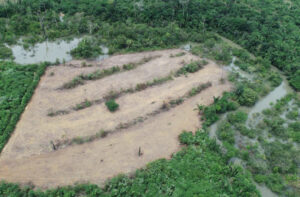Xiruo Wang
With the Paris Agreement calling out a 2°C target all over the world, the Swiss are trying to be the first group to reach negative emissions. What have they done? How far have they gone?
Net-zero goals for Switzerland
Over the last several decades, countries have collectively pledged to decelerate global warming and reduce greenhouse gas (GHG) emissions. As stated in the Paris Agreement (2015), governments set targets to prevent global warming from rising 2°C, and further pursue efforts to limit it to 1.5°C, compared to the pre-industrial levels. According to the IPCC SPM report (2021), we can achieve this only if countries significantly reduce GHG emissions from fossil fuel use and reach the net-zero target the sooner the better.
Owning a vulnerable alpine ecosystem, Switzerland is particularly affected by global warming, as its temperatures rise twice as quickly as the global average. Therefore, Switzerland has committed itself to reach climate neutrality by 2050, just like the European Union and the United States.
The Swiss Federal Council started developing the Long-term Climate Strategy in 2019, published in January 2021. This policy involves all sectors, especially transport, building, industry and food systems. This general inclusion requires fundamentally different approaches. For example, solutions for the building and transport sector are emerging through better heating plans and insulation, electrification and hydrogen fuel (Federal Council, 2021). However, there are currently no realistic replacement technologies to reduce emissions for agriculture and industry.
The largest point emissions in Switzerland are mainly the so-called “hard to decarbonise” industries: cement and waste-to-energy (Kehrichtverwertungsanlagen, KVA) plants. They are indispensable industries with high demand, while together, they emit about 5 Mt CO2 from fossil fuels every year, which is about 15% of the total emissions. In the recently published “Energy Perspectives 2050+”, using renewable energy, increasing energy efficiency, and removing a significant amount of carbon are the crucial strategies (Swiss Federal Office of Energy, 2021). Leading by this strategy, more and more research and start-ups will spring up, and the long-term prospects in Switzerland seem to be optimistic.

What is the carbon removal industry?
Like the “hard to decarbonise” industries, it is sometimes not possible or not enough to just reduce emissions – we also need to remove the current high-level CO2 in the atmosphere. Carbon capture and storage (CCS) is the crucial technology to tackle this problem. As straightforward as its name, CCS includes a three-step process: capturing the CO2 produced by power plants or industrial activities; transporting it; storing it in the geological reservoirs deep underground. In this way, CO2 will finally be considered stable and permanently removed.
CCS has a long history in the industry. The first CCS facility has operated since 1972 in the US, where the natural gas plant in Texas captures CO2 as part of its gas processing. Until 2019, there were 51 CCS facilities worldwide, with 19 of them in operation, 4 under construction, and the rest in different stages of development (Global CCS Institute, CO2RE Database). In total, they are supposed to capture up to 43 Mt CO2. This is undoubtedly a tiny number compared with global emissions. Nevertheless, with more pilot and demo projects planned, the cost will lower, and the capacity will rise and not be negligible. In short, although replacing fossil fuels is still the primary and cheaper approach to reducing emissions, CCS is yet a necessary technology to participate in carbon removal.
There are more other negative emission technologies (NETs) apart from CCS. Carbon usage can be implemented with CCS (i.e. CCUS). In this way, CO2 can be re-used in industrial production, turning into plastics or fizzy soda; but these will be small contributions. Direct air capture (DAC) is as simple and straightforward as it sounds – theoretically “scalable” (Minx et al., 2018), only it is now still pricey. Afforestation has the longest history among all NETs, but might also cost the longest time, and it always comes up with the criticism of extensive land use, taking up the space for agriculture and threatening food security. Research on NETs has been growing rapidly over the past decade, many of which are from ETH Zürich. Still, a gap exists between research interests and actual deployment. The Swiss carbon removal industry is the same case; however, the challenge also means vast opportunities for young professionals aspiring to such careers.

Afforestation in Amazon rainforests, Brazil. Criticism always emerges because industries are still exploiting the rainforest while restoring it. Can afforestation really help? Source: https://www.reforestaction.com/en/blog/brazil-results-our-amazon-reforestation-project
Current Focus in Switzerland
From 2010 to 2019, Switzerland has reduced 5 Mt of inland emissions. To reach the net-zero target by 2050, Switzerland should reduce emissions by 70–85% and remove the rest from the atmosphere. Situated in the centre of Europe, it has the advantage of helping to shape better CO2 networks in Europe, especially in transport. Currently, Swiss companies and institutes have close cooperations with CO2 storage facilities in the Nordic region: Northern Lights in Norway and Carbfix in Iceland, both of which have a great potential to hold CO2 permanently.

CO2 receiving terminal at the premises of Naturgassparken industrial area in the municipality of Øygarden in western Norway. Source: https://norlights.com/what-we-do/
Several groups across multiple departments in ETH Zürich are digging deep in either CCS or other NETs from different perspectives, both theoretically and practically. The sus.lab combines sustainability research with various industries such as waste-to-energy plants, providing technology options, assessing costs and feasibility, and developing action plans. The Separation Processes Laboratory, led by Prof. Marco Mazzotti, covers the whole CCS value chain, including designing the essential transport pipelines, developing DAC technologies, and tight collaborations with storage operations.
Having close contact with the industry, entrepreneurs have been emerging from ETH Zürich. Climeworks, founded in 2009 by two ETH alumni, has pioneered the world’s first commercial direct air capture plant in Hinwil, Zurich. In 2021, they launched the largest directed air capture and storage plant worldwide, “Orca”, located in Iceland, capable of capturing 4,000 tCO2 per year. Although DAC technology has been controversial due to its expensive cost, it is still a good start to encourage more innovations and development to scale up. As many would say, “it’s better than nothing”.

The Climeworks CO2 capture plant in Hinwil, canton Zürich, Switzerland. Source: www.climeworks.com
“We hope that our technology will play a critical role in keeping global warming below 1.5°C,” says Climeworks Co-CEO Jan Wurzbacher when interviewed by ETH Zürich Newsletter. With a clear perspective, leading policy and strong research and technology backup, Switzerland seems to have a promising prospect of reaching its net-zero goal.
References
Climeworks raises CHF 600 million. ETH Zürich. Retrieved from https://ethz.ch/en/news-and-events/eth-news/news/2022/04/new-eth-unicorn-climeworks-raises-chf-600-million.html
Conference of the Parties, Adoption of the Paris Agreement, Dec. 12, 2015
U.N. Doc. FCCC/CP/2015/L.9/Rev/1 (Dec. 12, 2015).
Global CCS Institute. Global CCS Facilities Database. Retrieved from https://co2re.co/
IPCC, 2021: Summary for Policymakers. In: Climate Change 2021: The Physical Science Basis. Contribution of Working Group I to the Sixth Assessment Report of the Intergovernmental Panel on Climate Change [Masson-Delmotte, V., P. Zhai, A. Pirani, S.L.Connors, C. Péan, S. Berger, N. Caud, Y. Chen, L. Goldfarb, M.I. Gomis, M. Huang, K. Leitzell, E. Lonnoy, J.B.R. Matthews, T.K. Maycock, T. Waterfield, O. Yelekçi, R. Yu, and B. Zhou (eds.)]. Cambridge University Press, Cambridge, United Kingdom and New York, NY, USA, pp. 3−32, doi:10.1017/9781009157896.001.
Minx, J. C., Lamb, W. F., Callaghan, M. W., Fuss, S., Hilaire, J., Creutzig, F., . . . del Mar Zamora Dominguez, M. (2018). Negative emissions—Part 1: Research landscape and synthesis. Environmental Research Letters, 13(6), 063001. doi:10.1088/1748-9326/aabf9b
Federal Council (2021). Long-term climate strategy to 2050. Retrieved from https://www.bafu.admin.ch/bafu/en/home/topics/climate/info-specialists/emission-reduction/reduction-targets/2050-target/climate-strategy-2050.html
Swiss Federal Office of Energy (SFOE) (2022). Energy Perspectives 2050+. Retrieved from https://www.bfe.admin.ch/bfe/en/home/policy/energy-perspectives-2050-plus.html